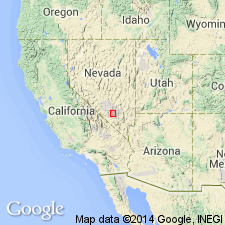
- Usage in publication:
-
- Grouse Canyon member*
- Modifications:
-
- Named
- Dominant lithology:
-
- Tuff
- Pumice
- AAPG geologic province:
-
- Great Basin province
Summary:
Named as one of eight members of Oak Spring formation for Grouse Canyon west of Yucca Flat, northern part of the Test Site, Nye Co, NV in the Great Basin province. Type locality is at Grouse Canyon. Section at Grouse Canyon shown on a cross section where it unconformably overlies the Tunnel beds of the lower member of the Oak Spring and underlies Survey Butte member (new) of Oak Spring. Divisible into a lower and upper part. Lower part is 0-400 ft thick gray, vitric tuff and zeolitic tuff in beds 2 inches to 3 ft thick, thin beds of fine, well-sorted, thinly laminated pumice, local pebbles, lenses of obsidian and fragments of granitic rock; has extensive greenish-gray and yellow laminated beds; phenocrysts make up 5 percent of the rock. Upper part is 0 to 175+ ft thick reddish-brown, greenish-gray, yellowish-gray, densely welded tuff that is eutaxitic, has black- and white-zoned lenses of flattened pumice up to 2 inches long, has local conglomerate and scattered pebbles of rhyolite and of granite; welded tuff has 3 to 9 percent phenocrysts of sanidine, anorthoclase, and quartz; black vitrophyre contains lenses of gray pumice and about 30 percent phenocrysts, chiefly feldspars; makes cliffs. Both parts present north to Indian Spring, south to Big Butte, east to Oak Spring Butte and west to Fortymile Canyon. Of Miocene? or younger age.
Source: GNU records (USGS DDS-6; Denver GNULEX).
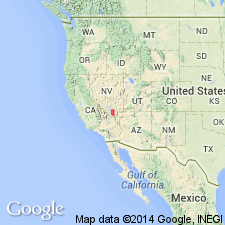
- Usage in publication:
-
- Grouse Canyon Member*
- Modifications:
-
- Revised
- AAPG geologic province:
-
- Great Basin province
Summary:
Reassigned from Grouse Canyon Member of Oak Spring Formation to Grouse Canyon Member of Indian Trail Formation of Oak Spring Group. Overlies Tub Spring Member of Indian Trail. Underlies Survey Butte Member of Piapi Canyon Formation of Oak Spring Group. Is a multiple-flow simple cooling unit of rhyolitic welded and nonwelded ash-flow tuff and associated ash-flow tuff. Wedges out south from Oak Spring Butte. Thickens and becomes more densely welded north of the butte. Is probably related to a volcanic center north of the Test Site. Of late Miocene or early Pliocene age. Cross section shows relation of member to other units in the Oak Spring from Skull Mountain (north) to area west of Oak Spring Butte (south), Nevada Test Site, Nye Co, NV in the Great Basin province.
Source: GNU records (USGS DDS-6; Denver GNULEX).
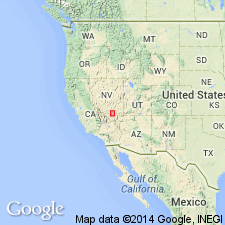
- Usage in publication:
-
- Grouse Canyon Member*
- Modifications:
-
- Revised
- AAPG geologic province:
-
- Great Basin province
Summary:
Underlies a large area north and west of the Nevada Test Site, Nye Co, NV, Great Basin province. Is assigned to the Indian Trail Formation, a formation restricted to the east part of the Test Site in this report, east of long 116 deg 15 min. West of long 116 deg 15 min in the west part of the Test Site, it is assigned as the upper member to the newly named Belted Range Formation. In the west part of the Test Site, it overlies and underlies local informal units. Is a compound cooling unit of gray to buff and brown, and locally brick red, comenditic (peralkaline soda-rhyolite) ash-flow tuff. Soda-rich sanidine is dominant phenocryst mineral. Fayalite, apatite, zircon, and sodic iron-rich clinopyroxene are minor ubiquitous phenocrysts. Is quartz free. Ash-fall and reworked tuffs formerly of the lower part of the member are treated as informal units of the formation. Ranges from 80 to 300 ft thick. Of Miocene or Pliocene age. Distribution map. Nomenclature chart. Term Oak Spring as a formation or as a group abandoned.
Source: GNU records (USGS DDS-6; Denver GNULEX).
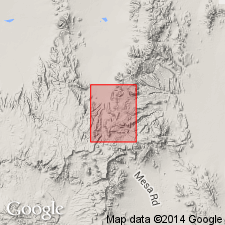
- Usage in publication:
-
- Grouse Canyon Member*
- Modifications:
-
- Age modified
- AAPG geologic province:
-
- Great Basin province
Summary:
Age of Belted Range Tuff and its members are shown on map of Quartet Dome 7.5' quad, Nye Co, NV, as Miocene and Pliocene(?) age. Belted Range Tuff underlies Miocene(?) and Pliocene tuff of Paintbrush Tuff.
Source: GNU records (USGS DDS-6; Menlo GNULEX).
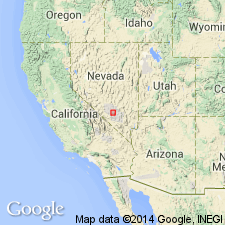
- Usage in publication:
-
- Grouse Canyon Member*
- Modifications:
-
- Age modified
- AAPG geologic province:
-
- Great Basin province
Summary:
Age of Belted Range Tuff and its members, Tub Spring and Grouse Canyon is late[!] Miocene based on 15 to 13 Ma assigned to volcanic center located on eastern Pahute Mesa. Grouse Canyon Member covered 3000 sq mi and had original volume of 50 cubic mi. Silent Canyon caldera formed during and/or just after eruption of Belted Range Tuff. [DNAG Scale, 1983, would be "middle Miocene"]
Source: GNU records (USGS DDS-6; Menlo GNULEX).
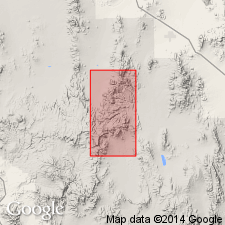
- Usage in publication:
-
- Grouse Canyon Member*
- Modifications:
-
- Revised
- AAPG geologic province:
-
- Great Basin province
Summary:
Belted Range Tuff is extended southward thereby extending use of members of Belted Range Tuff rather than of Indian Trail Formation which is geographically restricted from Wheelbarrow Peak-Rainier Mesa area. Grouse Canyon Member described on map as compound cooling unit of densely welded comenditic ash-flow tuff (0 to 360 ft thick). Age shown as Miocene.
Source: GNU records (USGS DDS-6; Menlo GNULEX).
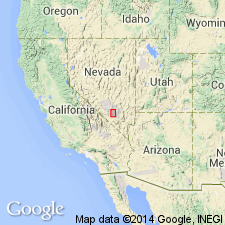
- Usage in publication:
-
- Grouse Canyon Member*
- Modifications:
-
- Revised
- AAPG geologic province:
-
- Great Basin province
Summary:
Indian Trail Formation of Nevada Test Site and vicinity herein abandoned. Belted Range Tuff and its members should now be used throughout Nevada Test Site and vicinity. Lower ash-flow tuffs of Indian Trail Formation now included in (ascending); Fraction Tuff, Redrock Valley Tuff and Crater Flat Tuff (all three now geographically extended).
Source: GNU records (USGS DDS-6; Menlo GNULEX).
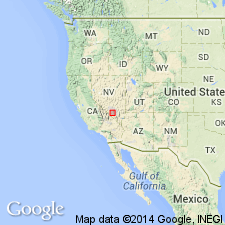
- Usage in publication:
-
- Grouse Canyon Tuff*
- Modifications:
-
- Revised
- Geochronologic dating
- AAPG geologic province:
-
- Great Basin province
Summary:
Within southwest Nevada volcanic field, Nye Co, NV, Great Basin province, units previously of formation rank are raised to group rank to allow for combining petrographically, geochemically, and temporally related lava flows and nonwelded tuffs with the principal correlative welded ash-flow tuff sheets (formerly members of the previous formation-rank tuffs). The ash-flow sheets are raised to formation rank and designated as "Tuff." Grouse Canyon is raised to formation rank and is lower of two formal formations of Belted Range Group (rank raised). Grouse Canyon was major ash-flow unit erupted concurrently with the collapse of Grouse Canyon caldera, the older part of the Silent Canyon caldera complex. Bedded peralkaline tuff at base of unit is referred to as bedded member rather that "tunnel bed 5" of previous usage. Overlies Tunnel Formation (new) and younger than comendite of Split Ridge of Belted Range; older than Dead Horse Flat Formation (new) both of Belted Range. Nomenclature chart (table 1). 40Ar/39Ar age of 13.7 +/-0.04 Ma (Miocene) determined on sanidine (table 3).
Source: GNU records (USGS DDS-6; Denver GNULEX).
For more information, please contact Nancy Stamm, Geologic Names Committee Secretary.
Asterisk (*) indicates published by U.S. Geological Survey authors.
"No current usage" (†) implies that a name has been abandoned or has fallen into disuse. Former usage and, if known, replacement name given in parentheses ( ).
Slash (/) indicates name conflicts with nomenclatural guidelines (CSN, 1933; ACSN, 1961, 1970; NACSN, 1983, 2005, 2021). May be explained within brackets ([ ]).

